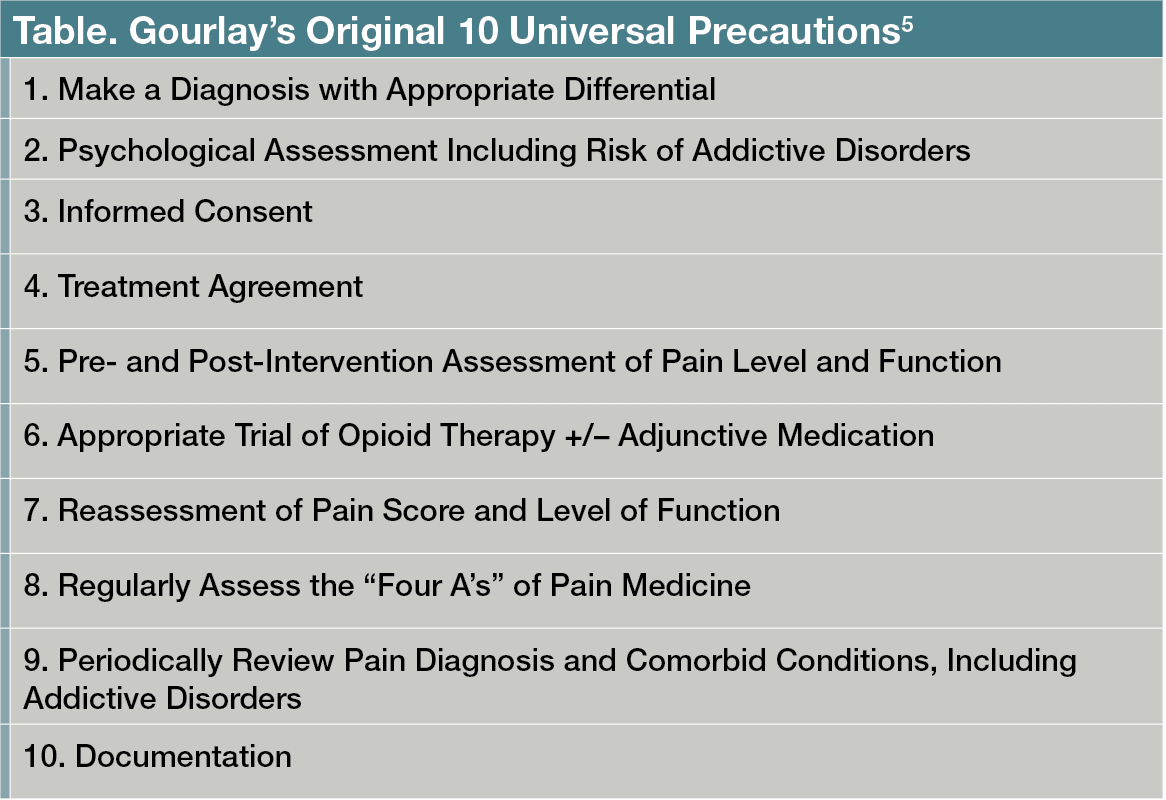CLINICAL REFLECTIONS
Sidebar. Eight Universal Precautions for Psychiatrists
1. Make a Diagnosis with Appropriate Differential
Patients complaining of anxiety and/or insomnia may have an underlying substance use disorder (SUD) that mimics an anxiety disorder. They may be experiencing drug side effects that may be ameliorated without adding a BZD.
2. Comprehensive Assessment Including Risk of Substance Use Disorders and/or Chronic Pain, including Family h/o SUDs
The cornerstone of a good comprehensive assessment is a thorough and careful clinical history, including a family history of SUDs. Patient-centered urine drug screening should be the rule, along with review of the state’s prescription monitoring program. Standardized risk assessment surveys may also be utilized.
3. Informed Consent
The possibility of synergistic side effects, including somnolence and respiratory depression, should routinely be covered.
4. Treatment Agreement
The range of aberrant drug-seeking behaviors should be covered in the treatment agreement (eg, lost prescriptions, early refills), with clarity regarding the standard response to such behaviors. When patients balk at the signing of a treatment agreement regarding controlled substance use and misuse, that often represents a red flag to be kept in mind as treatment decisions are made going forward.
5. Careful Consideration of Nonpharmacological Anxiety Reduction Strategies; and, non-BZD Alternatives Without Addiction Liability
Modalities like cognitive behavioral therapy, dialectical behavioral therapy, and meditation should be considered; as should less risky pharmacological options like buspirone, selective serotonin reuptake inhibitors, and serotonin-norepinephrine reuptake inhibitors.
6. Pre- and Post-Intervention Assessment of Anxiety Symptoms and Level of Functioning
The prescription of medications with potentially dangerous side effects is meant to improve a patient’s level of functioning. If functional level is deteriorating or simply not improving, a consultation or second opinion may be called for.
7. Periodically Review All Psychiatric Diagnoses and Comorbid Conditions, Including SUDs
Early on, and throughout the course of the patient’s psychiatric treatment, the routine use of patient-centered urine drug screens, prescription monitoring program database review, and pill counts, should be emphasized as components of routine treatment.
8. Documentation
All data that speaks to the presence or absence of active SUDs, especially opioid use disorder and aberrant use of BZDs, should be carefully documented in the medical record. Whenever possible and feasible, nonmental health providers involved with each patient should be privy to relevant data. The withholding of information from medical providers may indicate a significant current problem.
While the deadly opioid epidemic has progressed during the past 2 decades, more and more patients have left their doctors’ offices with prescriptions for benzodiazepine medications (BZDs). Across the medical profession, the percentage of outpatient visits resulting in a BZD prescription has increased from 3.8% in 2003 to 7.4% in 2015.1 It is estimated that concurrent use of BZDs and opioids may occur in as many as 50% of opioid overdose deaths.2 This shocking statistic suggests the possibility that more cautious and conservative use of BZDs by all who prescribe them has the potential to save thousands of lives per year.
Evidence of Misuse
During the time period studied by Agarwal et al,1 outpatient psychiatrists manifested a stable pattern of BZD prescribing, delivering BZD prescriptions to the patient in 30% of psychiatric visits. Overall, BZD prescriptions written by psychiatrists account for approximately one-sixth of the more than 25 million prescriptions that are written each year.3 In the years 2015 and 2016, 30.6 million US adults reported BZD use in the past year; of these, 5.3 million were deemed to be misusing BZDs.3 The most common type of BZD misuse occurs when prescribed BZDs are diverted and utilized by individuals who are not receiving them for a legitimate medical indication.
These threads of data suggest that some BZDs prescribed by psychiatrists end up being misused by individuals who are also misusing opioids, and that some of these opioid overdose deaths are potentiated by BZDs prescribed by a trusting psychiatrist. Are these BZDs that originate in mental health settings a factor in hundreds of yearly opioid overdose deaths, or in thousands? Although the magnitude of this problem is not known, it is likely that psychiatrists who exercise more caution in prescribing BZDs can play a role in doing less inadvertent harm.
Nearly a decade ago, Jones et al4 performed a comprehensive review of studies on the combined use of opioids and BZDs. They concluded that “that the co-abuse of opioids and BZDs is ubiquitous around the world,” that BZDs are utilized by many opioid abusers to potentiate opioid intoxication, and, that the co-abuse of opioid and BZDs “has negative consequences for general health, overdose lethality, and treatment outcome.”
Perhaps their 2012 conclusion that physicians should exercise more caution and vigilance in prescribing BZDs is reflected in the fact that psychiatrists have paid attention, and not increased our rate of BZD prescribing. Whereas psychiatric BZD prescriptive practices have remained stable, other physicians, especially primary care providers, are delivering nearly twice as many BZD prescriptions to patients.1 However, in view of the subsequent progression of the opioid crisis and the mounting overdose death toll, reducing the rate of BZD prescriptions in psychiatric practice may indeed be a worthwhile, life-saving consideration.
Gourlay et al5 suggest that by adhering to universal precautions in pain medicine, physicians are able to routinize a cautious, non-stigmatizing clinical approach that facilitates their ability to limit opioid prescriptions. It would likely be helpful for psychiatrists to adopt a parallel set of best practices and universal precautions with regards to prescribing BZDs and other psychoactive pharmaceuticals with abuse liability. Gourlay’s original 10 universal precautions can be found in the Table.5 See the Sidebar for a list of 8 universal precautions adapted from Gourlay et al5 for use by psychiatrists faced with the decision to initiate or continue pharmacotherapy with BZDs.
Discussion
Epidemiological studies suggest that individuals with untreated anxiety and mood disorders may be prone to self-medicate with nonmedical use of opioids. Use and misuse of opioid drugs may themselves aggravate symptoms of anxiety.6 It is not surprising, then, that outpatient psychiatrists sometimes provide BZD prescriptions to patients who may covertly be suffering from opioid use disorder. As substance use disorders (SUDs) have long been associated with behaviors that may be deemed antisocial,7 and one such behavior is deceptive communication,8 community-based psychiatrists in high-volume clinic settings may be at risk of being fooled by drug-seeking patients.
The ease of integrating some or all of the 8 suggested universal precautions for initiating or continuing BZD pharmacotherapy will vary from treatment setting to treatment setting. At the very least, this aspirational list of precautions may facilitate the ability of mental health professionals to offer a clinically sound integrated approach for the treatment of co-occurring psychiatric and SUDs. Integrated treatment of co-occurring disorders is the accepted standard of care for this challenging, high-risk patient population.9
Dr Adelman is a coaching and consulting psychiatrist, and is board-certified in psychiatry, addiction medicine, and coaching (BCC). He launched www.AdelMED.com after 8 years directing Physician Health Services, Inc. On the faculty of the University of Massachusetts Medical School, he is a consultant in psychiatry in the Division of Alcohol and Drug Abuse of McLean Hospital, an affiliate of Harvard Medical School.
References
1. Agarwal SD, Landon BE. Patterns in outpatient benzodiazepine prescribing in the United States. JAMA Netw Open. 2019;2(1):e187399.
2. Park TW, Saitz R, Ganoczy D, et al. Benzodiazepine prescribing patterns and deaths from drug overdose among US veterans receiving opioid analgesics: case-cohort study. BMJ. 2015;350.
3. Maust DT, Lin LA, Blow FC. Benzodiazepine use and misuse among adults in the United States. Psychiatr Serv. 2019;70(2):97-106.
4. Jones JD, Mogali S, Comer SD. Polydrug abuse: a review of opioid and benzodiazepine combination use. Drug Alcohol Depend. 2012;125(1-2):8-18.
5. Gourlay DL, Heit HA, Almahrezi A. Universal precautions in pain medicine: a rational approach to the treatment of chronic pain. Pain Med. 2005;6(2):107-112.
6. Martins SS, Fenton MC, Keyes KM, et al. Mood and anxiety disorders and their association with non-medical prescription opioid use and prescription opioid-use disorder: longitudinal evidence from the National Epidemiologic Study on Alcohol and Related Conditions. Psychol Med. 2012;42(6):1261-72.
7. Vaillant GE. Natural history of male alcoholism V: is alcoholism the cart or the horse to sociopathy? Br J Addict. 1983;78(3):317-26.
8. Young SR, Azari S, Becker WC, et al. Common and challenging behaviors among individuals on long-term opioid therapy. J Addict Med. 2020;14(4):305-310.
9. Kelly TM, Daley DC. Integrated treatment of substance use and psychiatric disorders. Soc Work Public Health. 2013;28(3-4):388-406.








